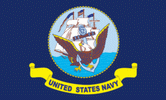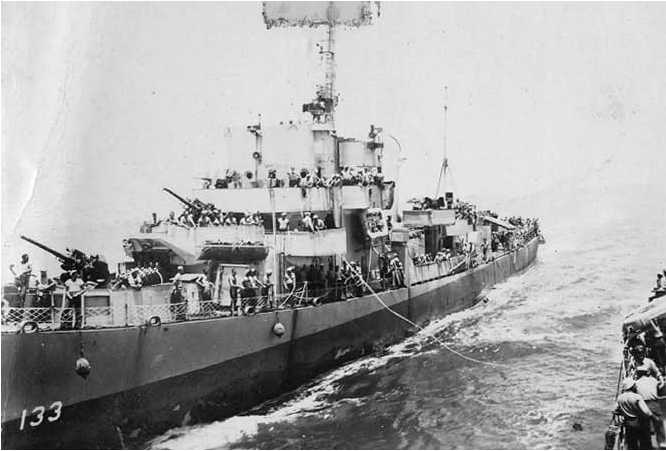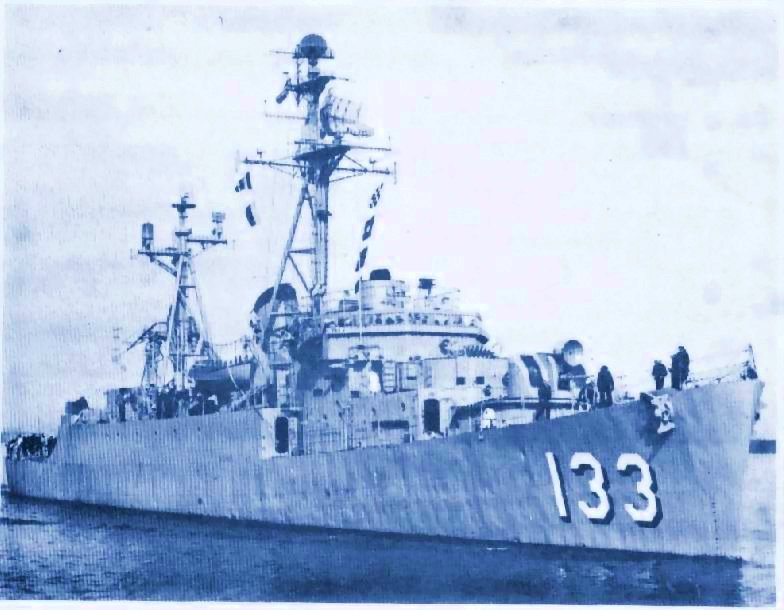The need for a Destroyer Escort class of ship came during WW2 to be used against the German U-Boat threat in the Atlantic. When needed, the Destroyer Escort could accomplish the mission of the larger Destroyer by attacking surface ships with guns and torpedoes and serving as scout ships of the fleet. The Destroyer Escorts proved this attack capability at the Battle of Samar.
A specially designed Destroyer was then built to protect transports in convoys, these lighter Destroyers were designated DEs, developed for anti-submarine patrols. The first DEs main battery were 3-3 inch/50 plus 2- 40 mm and 9-20 mm and depth charges, no torpedo tubes. Next the DEs, had two 5 inch mounts and a set of three torpedo tubes. There was little difference in their size and tonnage.
In 1975 all Destroyer Escorts then in commission were redesignated Frigates (FF) and the type name "DE" was discontinued by the US Navy.
With the constant threat of the U-Boat to Allied shipping the Destroyer Escort became a necessity. A Destroyer Escort could be built for about five million dollars compared to ten million for a Destroyer. They would be smaller than a Destroyer and not have the firepower, but they could accomplish many of the same task that the Destroyer was designed to do for half the cost. The order for 1005 Destroyer Escorts were placed,but only 563 would be built. This was due to the success the Destroyer Escort had in stopping the German U-Boat threat in the Atlantic. Some would be partially built and their construction was halted, and they would never be commissioned. Some of the remaining keels which had been laid were completed as other type ships such as APDs. The APD was a Attack Personal Transport.
Of the 563 Destroyer Escorts built during and shortly after WW 2, 78 were for England, 6 for France, and 8 for Brazil. The US Coast Guard would have 30 Edsall Class Destroyer Escorts under their command, they would be used mainly in the Atlantic. The rest of the DE's would be delivered to the US Navy to be used in the Atlantic and Pacific Wars. They would be used as convoy screens, anti-submarine warfare, shore bombardment, picket duties, surface engagements, electric power supply, and troop transports.
The first orders were only placed on November 1,1941 and the first keel laid at the Philadelphia Navy Yard. The first Destroyer Escort that was commissioned was the USS Brennan DE 13 on Jan 20, 1943, at Mare Island, Vallejo, Calif. the DEs would supply the United States Navy with the economical destroyer type ship which could be mass produced using less expensive material.
With the large amount of Destroyer Escorts to be ordered, there would not be enough shipyards available to build these warships. Even at the existing yards there would be a lack of space. To make up for this problem parts of the Destroyer Escort would be constructed at welding and fabrication shops across the United States and then when that piece or part of the ship was called for it would be sent, usually by rail to the shipyard for assembly of the ship.
After the end of World War II, many of the Destroyer Escorts were decommissioned and placed in moth balls. Some of these ships stayed in commission for several years. The machinery of a DE compared to that of the DD made the DE more suitable for Naval reserve duty. By 1950 the force of active DEs was reduced to 27 ships. During the Korean war the number of DEs in commission was increased to 52. In 1960 only 3 Destroyer Escorts served with fleet units. Another 28 DEs trained reservist. Mass scrapping of ships remaining in reserve began five years later. The last World War 2-built DEs were stricken in 1973. The Destroyer Escorts were known a heavy rollers, but also as good sea boats, at least in U.S. service. The Destroyer Escort provided a valuable service for the United States of America during World War ll.
No better example of this attack capability can be given than that of the Battle of Samar.
In 1975 all Destroyer Escorts then in commission were redesignated Frigates (FF) and the type name DE was discontinued by the US Navy. There would be six classes of Destroyer Escorts built.
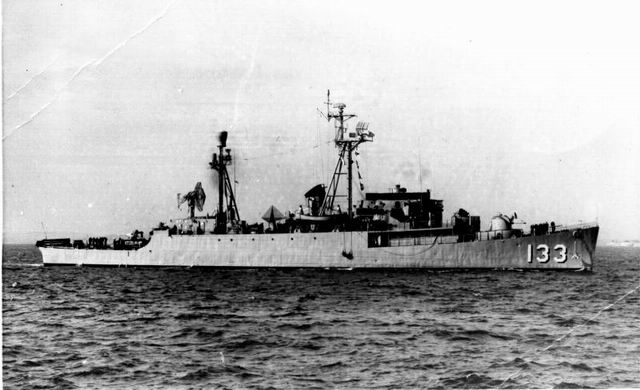
Destroyer Escorts lay silently(almost ghostly)in mothballs at the Pacific Reserve Fleet in San Diego after World War 2. Some of these ships after being commissioned were in the fleet for one or two years then decommissioned placed in mothballs and would never see duty again.
The Evarts Class They would be the known as the short hull Destroyer Escorts. They would be found to be unsatisfactory and this class of ship would be scrapped soon after WW 2.
Ships General Info
| Class |
Length |
Beam |
Power |
Horse Power |
Range Miles |
Displacement |
| Evarts |
289' 5'' |
35'1'' |
Diesel |
6000 |
4150 |
1436 |
| Buckley |
306' |
36' 9'' |
Steam |
12,000 |
4940 |
1673 |
| Rodderow |
306' |
36' 11'' |
Steam |
12,000 |
5050 |
1450 |
| Cannon |
308' |
36' 10'' |
Diesel |
6000 |
10,800 |
1525 |
| Edsall |
306' |
36' 10'' |
Diesel |
6000 |
5100 |
1490 |
| Butler |
306' |
36' 10'' |
Steam |
12,000 |
4650 |
1600 |
Generally the Ships carried 12-15 Officers and 175-200 Crewmen.
The DEs top speed was 20 to 24 knots. Generally cruised at 17 knots.
Ships Armament
| Class |
Main Battery |
Depth Charge Tracks |
Hedgehog |
K-Gun |
Triple Torpedo Tube |
Twin 40mm |
20 mm |
| Evarts |
3-3''/50 |
2 |
1 |
8 |
0 |
1 |
9 |
| Buckley |
3-3''/50 |
2 |
1 |
8 |
1 |
1 |
8 |
| Rodderow |
2-5''/38 |
2 |
1 |
8 |
1 |
2 |
10 |
| Cannon |
3-3''/50 |
2 |
1 |
8 |
1 |
1 |
8 |
| Edsall |
3-3''/50 |
2 |
1 |
8 |
1 |
1 |
8 |
| Butler |
2-5''/38 |
2 |
1 |
8 |
1 |
1 |
8 |
WW 2 Destroyer Escorts Damaged or Lost
| Ship |
Date |
Damage |
Cause |
KIA |
Wounded |
| Leopold DE 319 |
3/9/44 |
Sunk |
Torpedo |
171 |
? |
| Holder DE 401 |
4/11/44 |
Heavy Damage to Hull |
Torpedo |
? |
? |
| Donnell DE 56 |
5/3/44 |
Blew off Stern |
Torpedo |
29 |
25 |
| Fechteler DE 157 |
5/5/44 |
Sunk |
Torpedo |
29 |
26 |
| Barr DE 576 |
5/29/44 |
Stern Destroyed |
Torpedo |
17 |
14 |
| Rich DE 695 |
6/8/44 |
Sunk |
Struck Mine |
KIA 27 Miss 62 |
73 |
| Fiske DE 143 |
8/2/44 |
Sunk |
Torpedo |
32 |
50 |
| Sheldon DE 407 |
10/3/44 |
Sunk |
Torpedo |
? |
? |
| Dennis DE 405 |
10/25/44 |
Hull Damage |
Surface Action |
4 |
0 |
| Roberts DE 413 |
10/25/44 |
Sunk |
Hit by Enemy 14'' |
? |
? |
| Eversole DE 404 |
10/28/44 |
Sunk |
Torpedo |
0 |
139 |
| Liddle APD 60 |
12/7/44 |
Heavy Damage to Bridge |
Plane crashed into Bridge |
40 |
? |
| Fogg DE 57 |
12/20/44 |
Damaged Stern |
Torpedo |
15 |
2 |
| Blessman APD 69 |
2/18/45 |
Heavy Damage to Bridge |
Bomb hit Bridge Area |
47 |
23 |
| Foreman DE 633 |
4/3/45 |
Hole below waterline |
Bomb |
0 |
0 |
| Witter DE 636 |
4/6/45 |
Hull Damage |
Suicide Plane |
6 |
0 |
| Hopping APD 51 |
4/9/45 |
Hole in Hull |
Shore Battery |
2 |
? |
| Whitehurst DE 634 |
4/12/45 |
Heavy Bridge Damage |
Suicide Plane |
42 |
? |
| Rall DE 304 |
4/12/45 |
Hull Damage |
Bomb |
21 |
38 |
| Bowers DE 637 |
4/17/45 |
Heavy Bridge Damage |
Suicide Plane |
65 |
? |
| Davis DE 136 |
4/24/45 |
Sunk |
Torpedo |
115 |
|
| Oberrender DE 344 |
5/9/45 |
Heavy Hull Damage |
Suicide Plane |
24 K&W |
|
| England DE 635 |
5/9/45 |
Heavy Bridge Damage |
Suicide Plane |
37 |
25 |
| Chase APD 54 |
5/20/45 |
Heavy Hull Damage |
Suicide Plane |
0 |
? |
| Bates APD 68 |
5/26/45 |
Sunk |
Suicide Plane |
23 |
? |
| Loy APD 56 |
5/27/45 |
Hull Damage |
Suicide Plane |
3 |
15 |
| Gendreau DE 639 |
6/9/45 |
Hole n Hull |
Shore Battery |
2 |
2 |
| Underhill DE 682 |
7/24/45 |
Sunk |
Suicide Sub |
113 |
0 |
| Solar DE 221 |
4/30/46 |
Sunk |
Ammo Explosion |
165 |
65 |
Korean War
Seiverling DE 441 |
9/8/51 |
Fire Rm Flooded |
Shore Battery |
0 |
0 |
| Lewis DE 535 |
10/21/52 |
Hull Damage |
Shore Battery |
0 |
8 |
| Hanna DE 449 |
1952 |
Hull Damage & Fire Rm |
Shore Battery |
1 |
0
|
Destroyer Escorts During WWII
USS Buckley DE 51
On 22 April 1944 she joined hunter-killer TG 21.11 for a sweep of the North Atlantic and Mediterranean convoy routes. On the morning of 6 May aircraft from Block Island (CVE-21) reported an enemy submarine near The Buckley. She steamed toward the surfaced submarine evading her torpedoes and gunfire, and commenced firing. At 0328 The Buckley rammed the German submarine U-66 and then backed off. Shortly thereafter, the submarine struck The Buckley, opening a hole in the escort vessel's starboard side. The U-66 drew astern of The Buckley and sank at 0341 in 17°17' N., 32°24' W. The Buckley picked up 36 German survivors and then retired to New York where she underwent repairs until 14 June 1944.
USS England
On 18 May 1944, with two other destroyers, The ENGLAND cleared Port Purvis on a hunt for Japanese submarines during a passage to Bougainville. During the next 8 days, she was to set an impressive record in antisubmarine warfare, never matched in World War II by any other American ship, as she hunted down and sank I-16 on 19 May, RO-106 on 22 May, RO-104 on 23 May, RO-116 on 24 May, and RO-108 on 26 May. In three of these cases, the other destroyers were in on the beginning of the actions, but the kill in every case was The ENGLAND's alone. Quickly replenishing depth charges at Manus, The ENGLAND was back in action on 31 May to join with four other ships in sinking RO-105. This superlative performance won for The ENGLAND a Presidential Unit Citation.
USS Mason DE 529
The USS MASON, the first Navy ship with a predominantly Negro crew, departed Charleston 14 June escorting a convoy bound for Europe, The MASON would escort convoys six times across the Atlantic.
USS Pillsbury
On 4 June, about 100 miles off the Cape Verdes, sound contact was made on a U-boat trying to penetrate the destroyer screen for a shot at Guadalcanal. Two pilots sighted the submarine running under the surface, and splashed the sea with gunfire to point out the contact to Pillsbury, Jenks (DE-665), and Chatelain (DE-149) rushing to the attack. The destroyers fired their depth charges and in 13 minutes forced the submarine to the surface. In a withering fire of small ar ms and light gunnery the German gun crews were swept from the decks. Pillsbury lowered a boarding party and, in a drama reminiscent of old Navy days, the boarding party rushed on board and took as prisoners the U-boat Captain, five officers, and fifty-three of her crew. A 2,500 mile haul to Bermuda was made, with U-505 trailing meekly on the end of a tow line. The captured submarine revealed some of the German Navy's most guarded secrets. For this demonstration of conspicuous gallantry and achievement, Pillsbury was awarded the Presidential Unit Citation.
USS John C. Butler
Admiral Kurita's Center Force still transited San Bernardino Strait the night of 24-25 October and just after sunrise bore down on the relatively unprotected "Taffy 3," including JOHN C. BUTLER. The 2-hour battle off Samar which followed has taken a rightful place among the most memorable actions in naval history. The slow escort carriers launched all planes to attack the Japanese cruisers and battleships, and JOHN C. BUTLER and her sisters laid heavy smoke to confuse enemy batteries. A rain squall provided cover for a turn to the south, and just after 0730 the destroyers began their gallant torpedo attacks against great odds. JOHNSTON (DD-557), HOEL (DD-533), HEERMAN (DD-532), and escort SAMUEL B. ROBERTS (DE-413) made close-in attacks on cruisers and battleships, forcing them to zigzag, while aircraft made continuous attacks. Soon after this first attack, JOHN C. BUTLER turned from the carriers to launch her remaining torpedoes, then exchanged gunfire with a heavy cruiser. The destroyer escort continued to fire and dodge heavy-caliber fire until dangerously low on ammunition, then returned to the carrier formation to provide smoke coverage.
USS Samuel B. Roberts DE 412
When the order was given to the large FLETCHER Class destroyers of Taffy III to engage the Japanese, light-weight (BUTLER Class DE) ROBERTS joined fleet destroyers HOEL and HEERMANN on their torpedo attack. She chose HIJMS CHOKAI as the target for her three torpedoes and was credited with one hit. Later, she engaged the heavy cruiser HIJMS CHIKUMA with 5-inch gun fire and knocked out her #3 8-inch turret. In the thick of battle all morning long, ROBERTS was finally hit by several 8-inch shells after trying avoid 14-inch battleship shells from HIJMS KONGO. Eighty-nine men lost their lives on this, the only DE of Taffy III to be lost during the Battle Off Samar. Admiral C. A. F. Sprague, commander of Taffy 3, later described the next surprising development: "At 0925 my mind was occupied with dodging torpedoes when near the bridge I heard one of the signalmen yell, ‘. . . dammit, boys, they're getting away!’ I could not believe my eyes, but it looked as if the whole Japanese fleet was indeed retiring.... At best, I had expected to be swimming by this time." The Japanese, damaged and fearing heavier air attack, had indeed reversed course. Though the escort carriers lost two of their number and three escorts, their valiant fight had stopped the Japanese from attacking the transports in Leyte Gulf.
Typhoon
Life aboard a Destroyer Escort in a wild Pacific storm known as a typhoon is an experience a young sailor would remember for a long long time. Because the sailors were young, late teens and early twenties is probably why they could endure the wild rolling and pitching, the constant sound of the bow smashing into the huge waves.Then as the bow ducked under the wave, the stern would rise up out of the water and the sound of the screws turning in air would be a very nerve racking, especially at night when the crew was trying to sleep. That sound would last a short while, and then the stern would drop back into the sea making a terrible sound. like a heavy hammer hitting a large piece of steel and that sound would vibrate though the ship.
Everything that could move was lash down or it would become a flying object. As the ship would roll a twenty gallon trash can not tied down in the crews compartment might sail thirty feet till it hit the opposite side of the ship. Noise of the ships screws turning, trash cans rolling, the never ending sound of the ship battling the sea, and the pitching and rolling of the ship did not make ideal sleeping conditions. This would go on hour after hour, day after day.
Then of coarse there was matter of the crew being served three meals a day . A small thing such as a typhoon could not eliminate the young sailors craving for food. If three meals were served the young men would show up at the mess decks on time and ready to eat. It was truly amazing how they could hold their tray full of food, a cup of coffee or milk, their eating utensils, while sitting at a table holding a conversion and eating like it was just another meal. If it became so rough that the cooks could not prepare the meals then cold cuts would be served to make sandwiches. Those sandwiches would be devoured just as well as a regular meal. It is hard to believe anyone over forty years old could exist under those conditions.
Gunners Mates and Boatswains Mates
The duties of a Gunners Mate was quite simple, keep the guns in good operating condition, inspect them daily for anything you miss the day before, lubricate, clean and have the ability to brake down any part and repair or replace it in a hurry.
The 3 in.- 50s were simple and easy to operate but the 40’s had more working parts to contend with plus they were water cooled and always boiling over in the heat of battle.
Gunners were in charge of the depth charges, ammo, ammo storage, and small arms. Gunners also worked close with Fire Controlmen; they would help put the Gunners on target in the automatic control.
At General Quarters (Battle Stations) Gunners topside had two General Quarter stations, One was anti aircraft and surface engagement. The other one was Anti-submarine Warfare (asw). On ASW some of the Gunners were on one forward 3 in- 50 and others the after 40-mm. The rest of the Gunners were on depth charges and hedgehogs. The rated Boatswains Mates were also in charge of one or two depth charges or hedgehogs. There were not enough Gunners Mates to man all the stations, so a rated Boatswains Mate would be assigned a station. Non rated deck hands would be assigned to a station as a helper.
In port Gunners Mates and Boatswains Mates would stand watch on the quarterdeck armed with a 45 and a Non Rated deck hand as a messenger. Non Rated deck hands would also stand bow and stern watches.
At sea a Gunners Mate stood watch in after steering. A Non Rated deck hand stood helm watches, after lookout watch, port and starboard lookout on the wings of the bridge.
The Master At Arms was usually a Boatswains Mate 1/c or a Gunners Mate 1/c. The Master At Arms was in charge of the all the crews compartment cleaning, keeping the heads clean, and calling reveille in each of the crews quarters and turning on the lights. At night he would switch off the lights and switch on the red night-lights. The Master at Arms was usually in charge of the Mess Decks also. The Compartment Cleaners and Mess Deck Hands were Non rated personnel from all the different divisions aboard ship.
The Boatswains Mates were in charge of the Maintenance and painting of the exterior hull and most of the interior compartments. They were also in charge of the Captains Gig. The Boatswains Mates generally were the Coxswain of the Gig.
Radarmans Duties
Plot, give course, speed, and closest point of approach of any radar contact. Whether on the sea, in the air or underwater (Radarman worked with the Sonarman plotting submarine contacts). Communicate with all the other ships via voice radio.
During convoy duties it was the CIC (combat information center) job to recommend course and speed changes whenever the ship changed positions in the convoy. Radarmans duty to keep ship in right location such as the right distances from all other ships. Every ship had a certain way to turn and etc. to get to its new station.
Radar was also used as a navigational aid since it's range was of great help to the navigator in getting bearings and ranges to different land points at night and when the land points might be over the horizon.
Radarman had to keep up to date all of the navigational charts as to where the buoys and other land marks were. There are not many changes on the charts of US waters ,but when in foreign water such as in Korean waters it is a different story. All of the charts were of Japanese origin and nothing was up to date. That
is one of the reasons the Wiseman ran aground in Nov. '52 (uncharted waters).
When at sea Radarman usually stand a 4 hour watch with 8 off. Sometimes in tight situations a Radarman would stand 12 on and 12 off, You would need maybe 2 men on radars 2 on plot (maybe 3 if you were working anti-submarine duty). Normally you could get by with 4 on and 8 off.
R-DIVISION
The Repair Division made up of Pipefitters, Medalsmiths, Damage Controlman and Machinery Repairman. At times the ship would not have all these ratings aboard ship at one time. The Pipefitters ( Ship Fitters ) and Metalsmiths would do most of the Arc Welding, Gas Welding, Cutting , and Brazing. The Machinery Repairman would do all of the lathe work. Most of this work was done in the Machine Room located on the Main Deck about mid ship. Damage Controlman did the woodwork, what little there was on a DE.
Most of the tools, lathes, and welders were located in the Machine Shop. The Pipefitter Shop was located in the after part of the ship next to the steering room on the 2nd deck. The workbench with most of the tools a Pipefitter would use was located there. Fitters were know to sack out on the bench on Sat. and Sun. mornings if they did not want to be awaken by the Master At Arms. At sea this was not a good place because of the noise of the shaft and the screws turning close by.
On some DE’s. R Div. Personnel would serve as the engineer on the Captain’s Gig. He could be Rated or Non Rated as long as he was qualified to serve as the engineer.
R Division Personnel had the Roving Patrol Watch aboard the Wiseman. This was probably the best Watch aboard ship. The Watch would move all over the ship checking for flooding and fires. He would take soundings of all below deck compartments. He would check the shaft alley’s for excessive leakage or flooding.
He would check the two fresh water tanks port and starboard, and tries to keep equal amounts of water in each one for proper ballast. These tanks where located aft of the after engineroom, below the crews quarters. He would also check the chlorine residual of these tanks if they were being chlorinated. Bleach from the ships laundry was used to place in the ships water tanks. Once in every four-hour watch he would have to take the Watch Log to the Officer of the Deck for revue and signature.
When the ship went to General Quarters the R-Div personnel would be assigned to one of the three repair parties. One forward, one mid ship, and one aft. Each member of the repair party was assigned valves to close, watertight doors and hatches to close. Any watertight door or hatch could not be opened without permission from the Damage Control Officer or until General Quarters was secured. The Repair Party duties were to fight fires, control flooding and to repair damage to the ship during combat.
Tin Can Sailor
God's own sailors, the real men of the blue water (deep ocean) navy, i.e., Destroyer Sailors. Not to be confused with the wimps and civvies that sail in subs and carriers.
Did You Know
On a Destroyer Escort, the space allowed in the crews compartment for each crewmen was 1/6th the space allowed for a prisoner in a US Federal Prison during WW2.
| | |
|
USS Pillsbury DE/DER-133 History Index
|
| USS Pillsbury DE/DER-133 Site Guide |





We salute and support all our Armed Forces.
This website developed and operated by
ETC USN Retired Michael Lambert of Smyrna,
Georgia.
It is hosted on server space donated in perpetuity by
Tripod.Lycos.COM as a gesture of respect to
the gallant men of the DE/DER's and their sacrifice for our nation during WW II and Cold War.
Copyright: None. The included history belongs to the ages.
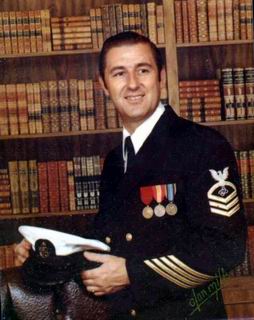
Contact
Webmaster:
